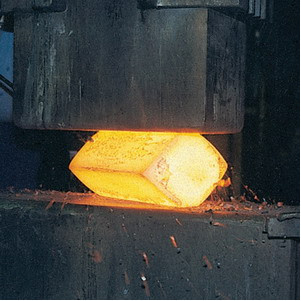Forging process is perhaps the oldest metal working process and was known even during prehistoric days when metallic tools were made by heating and hammering.
Forging is basically involves plastic deformation of material between two dies to achieve desired configuration. Depending upon complexity of the part forging is carried out as open die forging and closed die forging.
In open die forging process, the metal is compressed by repeated blows by a mechanical hammer and shape is manipulated manually.

In closed die forging, the desired configuration is obtained by squeezing the workpiece between two shaped between two shaped and closed dies.
In forging process the forces are applied on the raw material such that the stresses induced are greater than yield and less than ultimate so that material is experiencing plastic (or) permanent deformation to get required shape. But in forging operation force applied can be either continuous or intermittent impact loads.
Types of forging methods:
1 Based on the method of force application
1. Hand forging (Drop hammer type)
2. Machine forging (Mechanical or hydrostatic forging)
1.1 Hand forging:
Hand forging always uses drop hammer type. Because the continuous force by the human hand, it is not sufficient to produce the deformation in work piece.
1.2 Machine forging:
In machine forging because the required force is obtained from machine it is possible to use either continuous force application or intermittent impact load application.
2. Based on method of shape obtained
1. Open die forging
2. Closed die forging
3. Semi die forging
2.1 Open die forging
§ In open die forging operation only drop hammer type of force application will be used.
§ Press forging is not used since there is no time fr changing the position of component.
Features of open die die forging:
§ Repeated impact blows are given on the work.
§ Less dimensional accuracy.
§ Suitable only for simple shapes of work.
§ Requires more skill of the operator.
§ Usually used for a work before subjecting it to closed die forging (to give approximate shape.
§ Dies are simple and less expensive.
§ It can be analyzed much easily.
§ it is the simplest of all forging operations.
2.2 Closed die forging
§ Closed die forging is also called as impression die forging because the shape of the dies is impressed on the component.
§ In this the type of forging force application may be either press forging type or drop hammer type will be used.
Features of closed die forging:
§ Closed die forging involves two or more steps:
1. Blocking die: Work is rough forged, closed to final shape.
2. Finishing die: Work is forged to final shape and dimension.
§ Both blocking die and finishing die are machined into the same die block.
§ More number of dies are required depending on the complexity of the job.
§ Two die halves close-in & work is deformed under high pressure.
§ High dimensional accuracy/close control on tolerances.
§ Suitable for complex shapes.
§ Dies are complex and more expensive.
§ Large production rates are necessary to justify high costs.
2.3 Semi closed die forging operation
§ Only drop hammer type of force application is possible.
§ In case of open die and closed die forging operations the volume of raw material required is remaining same as that of the volume of final finished component. But in case of closed die forging operation the volume of the raw material is about 10% to 20% more than final component to be obtained.
§ To accommodate the excess volume of material it is required to provide some open space dies also called gutter.
§ Because of provision of gutter the flash is produces in the forged component.
§ This flash is unwanted material which has to be removed by trimming operation.
§ Flash and gutter is used only in case of closed die operation but not in open die or semi closed die forging operation.
Advantages of forging:
Some common advantages of choosing forging operation are listed below:
1. Forged parts possess high ductility and offers great resistance to impact and fatigue loads.
2. Forging refines the structure of the metal.
3. It results in considerable saving in time, labor and material as compared to the production process of similar item by cutting from a solid workpiece and then shaping it.
4. Forging distorts the previously created unidirectional fiber as created by rolling and increases the strength by setting the direction of grains.
5. The forged parts can be welded easily.
6. Because of intense working, flaws are rarely found, so have high reliability.
7. High accuracy may be obtained in forging operation.
Disadvantages of forging:
Few disadvantages of choosing forging operation are listed below:
1. Rapid oxidation in forging of metal surface at high temperature results in scaling which wears the dies.
2. It is difficult to maintain close tolerances in forging operations.
3. Forging is limited to simple shapes and has limitation for parts having undercuts etc.
4. Some materials are not readily worked by forging.
5. The initial cost of forging dies and the cost of their maintenance is high.
6. The metals gets cracked or distorted if worked below a specified temperature limit.
7. The maintenance cost of forging dies is also very high.
Safety Precautions in Forging Shop
Some safety precautions in forging shop to followed while performing forging operation to avoid injuries and accidents are listed below:
1. Always avoid the use of damaged hammers.
2. Never try to strike a hardened surface with a hardened tool.
3. No person should stand in line with the flying objects.
4. Always use the proper tongs tool to grip and lift objects according to the type of work.
5. The anvil should always be clean and free from moisture and grease while in use.
6. Always wear proper clothes such as apron, foot-wears and goggles.
7. The handle of the hammer should always be tightly fitted in the head of the hammer.
8. Always put out the fire in the forge before leaving the forging shop.
9. Always keep the working space clean and tidy.
10. Proper safety guards should be provided on all revolving parts.
11. Head of the chisel should be free from burrs and should never be allowed to spread.
12. During machine forging, always observe the safety rules prescribed for each machine.
13. One must have the thorough knowledge and working of the forging machine before going to operate it.


